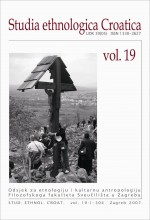Sveci zaštitnici u pobožnosti zajednice: studija o Krivom Putu kod Senja
Patron Saints in Community Religiosity: A Case Study from the Croatian Village of Krivi Put
Author(s): Marijana BelajSubject(s): Christian Theology and Religion, Customs / Folklore, Cultural Anthropology / Ethnology, Rural and urban sociology
Published by: Sveučilište u Zagrebu, Filozofski fakultet
Keywords: religiosity; patron saints; Krivi Put;
Summary/Abstract: Belief in patron saints belongs to the field of non-institutional religious concepts and practices, i.e. to popular religiosity. From the believers’ standpoint these practices are not opposed to the official religious system (in the researched area the official religion is Catholicism). This paper was based on the research conducted in the villages and hamlets in the region of Krivi Put near the town of Senj in 2004. I was interested in the ways in which patron saints were present in people’s lives, in their possible roles and importance the community was ascribing to them. The emphasis was placed on specific occasions during which we encountered these beliefs and on the practices through which they were expressed. All the familiar examples of religious practices linked to the belief in patron saints were covered in this research (for example, various vows, pilgrimages, processions, etc.), but taking into account the context of calendar customs proved to be a useful research strategy. It provided us with the insight into different non-institutional practices and the accompanying beliefs taking place on the Saints’ Days. The focus of this article is on dulia, but the correct interpretation of the worship of saints is sometimes impossible without taking into account the findings on the worship of the Mother of God (hyperdulia). The same can be said for the people of Krivi Put. Our Lady of Snow is the most popular patron saint in the region of Krivi Put. She is the titular of the local church, her Day is the central social event of the year, she is perceived as the powerful patron in times of need and therefore she seems to be an important element in self-identification of the people of Krivi Put and, in the same time, the most popular saint in personal religiosity. Regarding her patron role and the ‘place of dwelling’, she is sometimes supplemented in personal religiosity by Our lady of Krasno whose church is situated in the immediate vicinity (the village of Krasno is a popular Croatian pilgrimage site). Even though the set framework of dulia can create the impression that other patron saints are less present in popular religiosity, the context of calendar customs provides us with a different image. In the village of Krivi Put those saints were commonly ascribed the role of ensuring economic betterment, either directly or through different practices or prohibitions which had to be observed on their Day. Changes in the way of life are reflected in the ways of saints’ worship, however, according to my field data, this does not have to result in abandonment of particular patron saints, but, rather, in modification of their patron roles. The Saints’ Days are in this region commonly linked to events in nature and these, in turn, are connected to agricultural year. These days are celebrated independently and without restrictions from the Church: free usage of the branches blessed in church or holy water in folk blessings; divinations and predictions of future events; prohibitions of everyday activities, all connected with the images of Christian saints who are believed to have influence on events in nature and our earthly needs. Finding solutions to our earthly problems, according to my data, is the basic purpose of the relationship with the sacred and an important characteristic of the religiosity in the researched region. Beliefs and procedures which are part of the popular religiosity in the village of Krivi Put can be divided into two groups. In the first group we can recognize the traces of pre-Christian beliefs linked to events in nature which have a Christian coating. The second group has Christian background, but, in their materialization, people have re-interpreted them according to their own needs. However, the knowledge of the origin of these beliefs and the related procedures does not have to be a prerequisite for discovering their current meaning – whatever type of beliefs we are talking abut, the people perceive them as absolutely Christian, regardless of their non-Christian elements.
Journal: Studia ethnologica Croatica
- Issue Year: 2007
- Issue No: 19
- Page Range: 47-76
- Page Count: 30
- Language: Croatian

